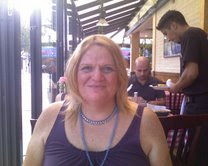As someone who pays attention to language, I found the modifications made to the marriage ceremonies performed today very interesting.
They may seem minor, as matters of language often seem to many people. However, a judge couldn't very well pronounce two people of the same sex, "man and wife." Instead, the judges pronounced the marriages "consummated" and referred to both members of the couple as "spouses."
What a lot of people don't realize is that changing the vows actually makes both members of the couple more like equals than the traditional vows do. Note that the judge, clergyperson or whoever else performs the ceremony usually says, "man and wife." In that arrangement, the man's status does not change. However, the woman ceases to be whomever she was before the ceremony; now she is the wife of the man. In other words, she is now defined by her relationship to the man, while the man is not defined by his relationship to the woman.
So, in modifying the marriage vow and the pronouncement, the judges who married hundreds of same-sex couples today in New York showed something that many of us have long understood: Gay rights and gender equality go hand-in-hand. Perhaps this is what some opponents of same-sex marriage, or LGBT rights in general, fear. It's simply not possible to have same-sex marriages if one member of the couple has to subsume his or her identity and redefine him or herself as an appendage of someone else. That concept of gender relations and marriage is outmoded, anyway.
They may seem minor, as matters of language often seem to many people. However, a judge couldn't very well pronounce two people of the same sex, "man and wife." Instead, the judges pronounced the marriages "consummated" and referred to both members of the couple as "spouses."
What a lot of people don't realize is that changing the vows actually makes both members of the couple more like equals than the traditional vows do. Note that the judge, clergyperson or whoever else performs the ceremony usually says, "man and wife." In that arrangement, the man's status does not change. However, the woman ceases to be whomever she was before the ceremony; now she is the wife of the man. In other words, she is now defined by her relationship to the man, while the man is not defined by his relationship to the woman.
So, in modifying the marriage vow and the pronouncement, the judges who married hundreds of same-sex couples today in New York showed something that many of us have long understood: Gay rights and gender equality go hand-in-hand. Perhaps this is what some opponents of same-sex marriage, or LGBT rights in general, fear. It's simply not possible to have same-sex marriages if one member of the couple has to subsume his or her identity and redefine him or herself as an appendage of someone else. That concept of gender relations and marriage is outmoded, anyway.









